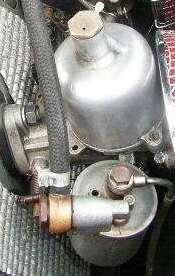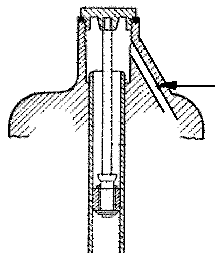The MGA With An Attitude
"DUSTLESS" CARBURETORS -- CB-105A

 A close look at the brass damper cap at top of the picture above reveals a small drill hole (little black dot) in the cap for ventilation (vented type damper cap). Also notice the cast rib on outside of the cover just below the cap. The diagram to the right shows an internal drill hole (see arrow) through that rib to vent the top chamber to the lower chamber. Some carburetors have the top vent hole, but not all. Some carburetors have the lower vent hole, but not all. The trick here is that you need exactly one of these holes, but not both.
A close look at the brass damper cap at top of the picture above reveals a small drill hole (little black dot) in the cap for ventilation (vented type damper cap). Also notice the cast rib on outside of the cover just below the cap. The diagram to the right shows an internal drill hole (see arrow) through that rib to vent the top chamber to the lower chamber. Some carburetors have the top vent hole, but not all. Some carburetors have the lower vent hole, but not all. The trick here is that you need exactly one of these holes, but not both.
As the dashpot internal piston rises and falls with carburetor air flow, oil level around the small damper rises and falls past the damper piston. This displaces air in the small top chamber, and that air must be vented somewhere. Early carburetors (all MGA 1500 according to the SPL) had no vent hole in the damper cap, making them the dustless type carburetors. Later design (all MGA 1600 and most NGB) had the small hole in the cap but no internal hole in the housing. If you have no vent hole the engine will run badly as the piston will rise and fall very slowly making it lean on acceleration (low power) and rich on deceleration (backfire). If you have both vent holes the engine will run really bad as it spoils the chamber vacuum, and the piston may only rise a little or none at all.
So if your engine runs badly, at least once during your ownership of the car you should inspect these parts to assure that the carburetors have exactly one of these vent holes, but not both holes.
Addendum, August 20, 2012:
A friend recently mentioned that his car has a mixed set of carburetors, one early type with vent hole in the top cap and one later type with vent hole in the bell cover. In this case you must be careful not to switch the damper caps, which would screw up operation of both carburetors. If you have a mixed set like this, then maybe mark the bell covers to remember which is of which type so you can remember which cap goes on which carburetor.
Addendum, October 12, 2012:
For the Chamber And Piston Assembly and Cap And Damper Assembly, the 1500 and 1600 parts have different numbers, and the numbers changed with the model change. Nothing changed during 1500 production, and nothing changed during 1600-1622 production. It is a nice little reminder for the purpose of originality. The 1500 cars originally had the non-vented top cap and vented chamber. The 1600 and 1600-MK-II cars originally had the vented top cap and non-vented chamber.
|